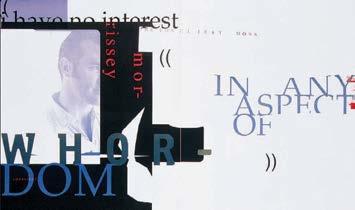
2 minute read
The End of Print | David Carson, and Lewis Blackwell 1995
The End of Print David Carson, Lewis Blackwell 1995
[…] Content is the big issue in design today. The question is what relationship does the visual language have with the verbal one? We think we are so familiar with our own (verbal) language, it comes as a shock to realize it is never received pure, without being coloured by the transmission. We are used to seeing words as the content and then either as text that is typeset for a layout and perhaps illustrated, or perhaps as a script that is performed live or to a camera, again framed and illustrated in various ways. However, we are increasingly aware that these words change in the telling: the emphasis, the context, the distractions. And we are aware that these words cannot exist in communication without some form of telling: thus the shaping and the shaper of that visual/verbal language inevitably goes beyond the word or the writer.
Advertisement
Perhaps this changing perception is one explanation of why the designer has been thrust up as some kind of hero of our age over the past decade: suddenly these former crafts operatives are seen as genius arch-manipulators that can make the world a better or worse place. This hype obscures the fact that any designer is just part of the whole process too, only able to add a personal contribution as an artist may or to abnegate this contribution and simply operate as some technician in the vast message machine that goes on operating all around us. But some people do stand out for expressing matters many thousands every day. […]
David Carson and Chris Cuffaro (photographer), “Morrissey: The Loneliest Monk,” Ray Gun, 1994.
RIGHT, THE PAGES DON’T FIT. Against those columns of text, neatly boxed pictures, steady relationships of headline and body copy and captions, numbered leaves, these freeform inked sheets are more akin to paintings than publication design. The reliable features that dominate our daily diet of print are here questioned played with, broken, or simply ignored.[…]
“YOU CANNOT NOT COMMUNICATE” is the designer’s belief as he seeks to explore the full range of expression possible within the page. The work has moved to an integration of word, image and the medium, seeking to forge a new way of reading across sequential pages. From the early Transworld Skateboarding work to the more recent Ray Gun, there is an evolution from one-off visual and verbal playfulness to a position of, at times, graphic abstraction. Increasingly marks and color exist not as elements that build or frame pictures and sentences, but make emotional contact directly as marks and color. They are not metaphors, but often seem to exist beyond rational explanation.






